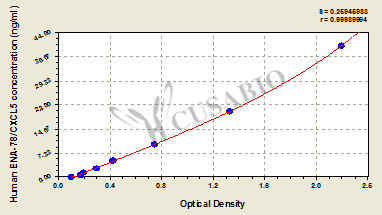The product CSB-E08178h is a sandwich ELISA kit developed to measure levels of human ENA-78 in multiple samples, including serum, plasma, or tissue homogenates. This assay uses the sandwich enzyme immunoassay technique in combination with the enzyme-substrate chromogenic reaction to quantify the analyte in the sample. The color develops positively to the amount of ENA-78 in samples. The color intensity is measured at 450 nm via a microplate reader.
ENA-78, alternatively referred to as CXCL5, is identified as an inflammatory mediator with a powerful role in neutrophil chemotaxis. CXCL5 is upregulated in many cancers including gastric cancer, hepatocellular carcinoma (HCC), breast cancer, and bladder cancer, and is involved in tumor growth and metastasis. In the tumor microenvironment (TME), CXCL5 binds to CXCR2 and participates in the recruitment of immune cells, and promotes angiogenesis, tumor growth, and metastasis. The CXCL5/CXCR2 axis can act as a bridge between tumor cells and host cells in TME. Blocking the transmission of CXCL5/CXCR2 signals can increase the sensitivity and effectiveness of immunotherapy and slow down tumor progression.




